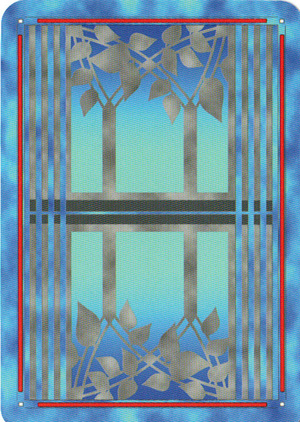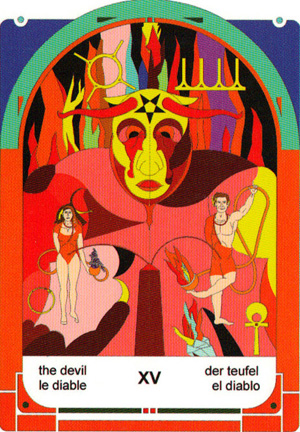
This book and deck set is “An upbeat expression of Tarot to develop your ideas and imagination”, and provides a different approach than many other tarot sets by allowing each one of the 78 tarot cards to talk to you and express their own individual personality. The Fool leads us into the land of Mystereum, “a journey of creativity and imagination where you are the guide.”
The back of each card is adorned with a muted blue-green computer-generated symmetrical design of two trees mirrored on the long ends of each card, with a small rectangular red border around the outside of the picture. Don’t get used to this color scheme, however, because when you turn over the cards you’re in for a shock. Bright primary colors are the rule for this entire deck, and each card image is framed in a border of red and blue, with a rounded aqua edge at the top of the image, almost to suggest that the reader is looking through a window. To me, it definitely seemed that the artist’s background in architecture came into play through the “arch”. All of the cards have a white section at the bottom with the card title, number or name—with Roman numerals for the majors and Arabic numerals for the pips.

The familiar RWS imagery is not completely absent here, but when it shows up its expressed in a different way than you might expect. The Wheel (of Fortune), for example, shows a light green wheel with a landscape in the background—a river flows through the middle of the wheel diagonally from top left to bottom right—with only four symbols on it: The astrological symbols for Libra, Aquarius, and Sagittarius, and an OM. like the very small hourglass near the river on The Wheel card, ostensibly reinforcing the message of “time.”
I definitely had trouble getting into the artwork on the cards, which was just not to my taste. Moreover, artwork aside, there did not seem to be a lot in each image to suggest divinatory meaning. The Nine of Swords has 9 swords haphazardly strewn around the card against a landscape and a red and orange sky darkening to black and grey as you head toward the aqua arch. You would naturally look to the book to provide the meaning, but as you’ll see below, that presents challenges of its own. 
Like Tarot: The Kingdom Within, this Schiffer offering has a full-size book with the deck, but it left me perplexed in many areas. This surprised me, especially since Mystereum bills itself as “Written for novice and intermediate readers and an excellent teacher’s tool.” I liked that the cards spoke for themselves; each card speaks to the reader in the book and gives insights into the card meanings, and there is a section on each card that introduces it. A cheat sheet at the end of the book gives a quick meaning for each card, but unfortunately, I couldn’t get behind many of the explanations, many of which have nothing to do with standard tarot interpretations.
With that said, I wouldn’t feel comfortable giving this to a beginning tarotist simply because it seemed too vague to me. My guess is that they are trying not to limit the intuition, imagination or vision of the reader by providing specific guidance—I immediately thought of “Pigs and fishes surround you” from Morgan’s Tarot, that iconic “counterculture” set from 1970—but Mystereum felt way too New Age for me. The introduction to the Devil, for example, included this text: “Sense what is intense and be highly aware of its energy. Intensity is much like when your identity is fully present. Odds are you are not mean. If you are not mean, then it is dang hard to make decisions or act anything NEAR [sic] mean. That sure is amazing! So smile, let go, and be amazed with yourself and your ideas! […] Abolish the toxins of your fears. Feel the purity of your desires. Experience emancipation! Free your ideas!” When the Devil himself speaks to the reader, he begins with “Huuuuurrrrrrooooo!!!!! How RRRRR UUUUU?” and ends with “Vroooom! Vroooooooommmmmmm!” What’s in between is mildly interesting reading but doesn’t give a lot of insight in what the card means at all, even though many RWS symbols appear in this particular card image.

The editing of the book left something to be desired as well, although I will admit it may have been done on purpose. Some words are capitalized in the middle of sentences, and in many places the text feels extremely repetitive. It’s the first time I’ve ever seen emoticons in a tarot book (J is often used in the text), and some of the text is written in a very conversational style, such as “Kewel!” [Cool] when the cards themselves speak.
I’d recommend this set for intermediate tarotists who want to focus on very positive, fluffy-bunny outcomes, or for imaginative/intuitive development. It may be difficult to get into the head space to use this deck for divinatory purposes, but it certainly makes a fantastic collector’s item.
~review by John Marani
Author: Jordan Hoggard
Schiffer Publishing
$34.99
Originally published in the American Tarot Association’s Quarterly Journal, Summer 2011 issue.
